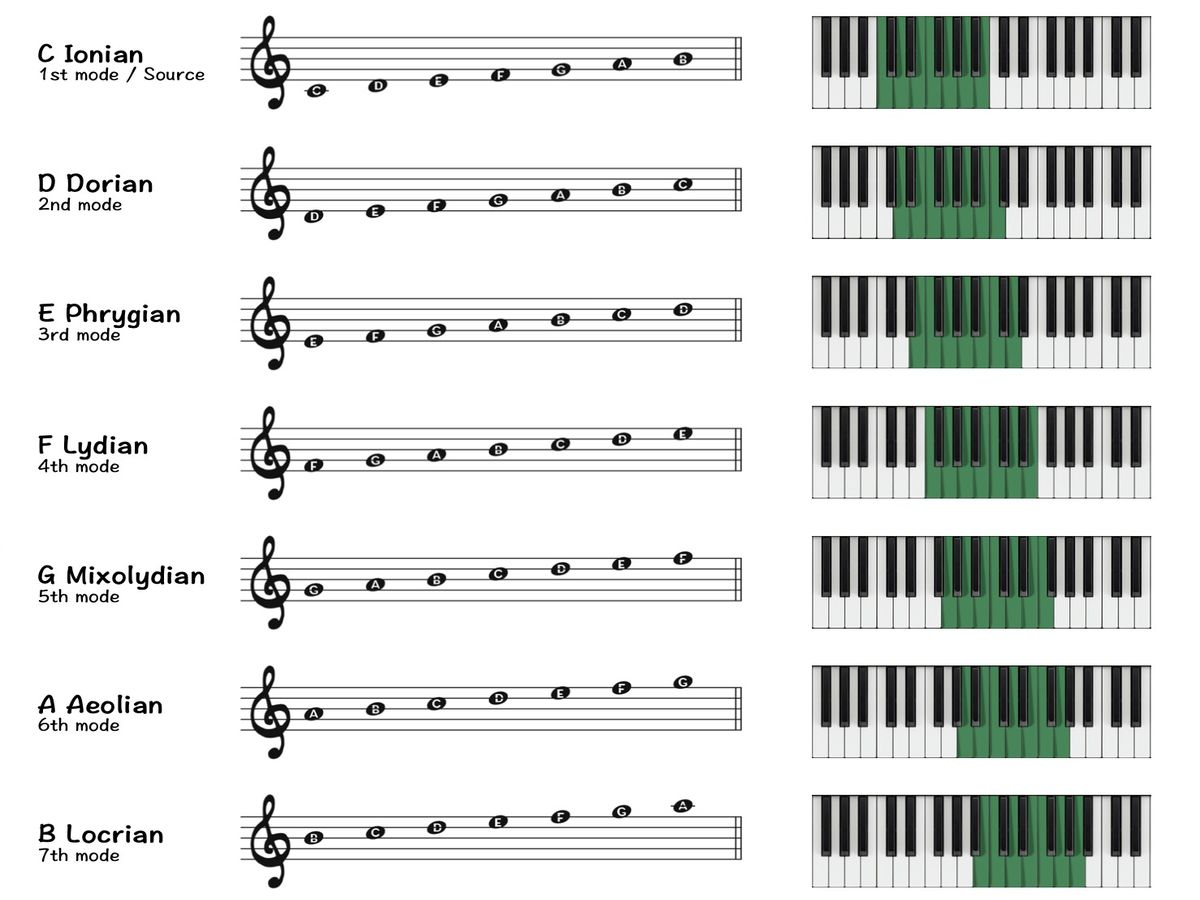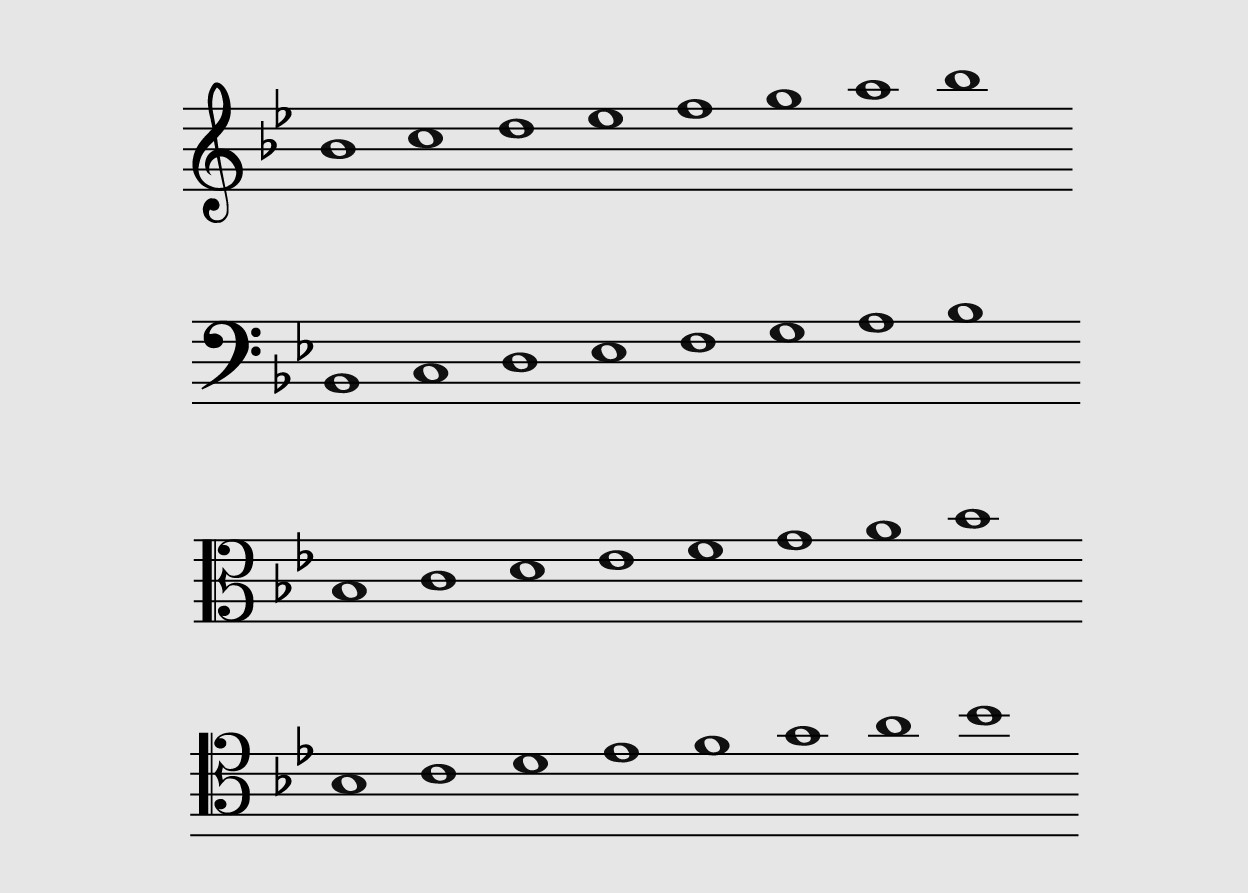Home>Production & Technology>Music Theory>Music Theory How To Use Major Pentatonic Scale


Music Theory
Music Theory How To Use Major Pentatonic Scale
Modified: February 12, 2024
Learn how to use the major pentatonic scale in music theory and enhance your musical compositions. Discover tips, techniques, and practical applications.
(Many of the links in this article redirect to a specific reviewed product. Your purchase of these products through affiliate links helps to generate commission for AudioLover.com, at no extra cost. Learn more)
Table of Contents
- Introduction
- What is the Major Pentatonic Scale?
- Constructing the Major Pentatonic Scale
- Understanding the Interval Structure
- How to Use the Major Pentatonic Scale
- Playing Melodies with the Major Pentatonic Scale
- Creating Solos using the Major Pentatonic Scale
- Harmonizing Chords with the Major Pentatonic Scale
- Conclusion
Introduction
Music theory is the foundation of understanding and creating music. It provides musicians with the tools to analyze, compose, and perform. One important aspect of music theory is scales, which are fundamental building blocks of melodies and harmonies.
In this article, we will dive into the world of music theory and explore the major pentatonic scale. The major pentatonic scale is a versatile and widely used scale that can bring a fresh and melodic flavor to your musical compositions.
Whether you are an aspiring musician, a seasoned player looking to expand your musical vocabulary, or a music enthusiast wanting to delve deeper into the intricacies of music theory, understanding and utilizing the major pentatonic scale will provide you with a wealth of creative possibilities.
In this article, we will discuss what the major pentatonic scale is, how it’s constructed, and most importantly, how you can incorporate it into your musical endeavors to create captivating melodies, solos, and harmonies.
If you’re ready to unlock the power of the major pentatonic scale and take your musical compositions to the next level, let’s dive right in!
What is the Major Pentatonic Scale?
The major pentatonic scale is a musical scale consisting of five notes. It is a subset of the major scale and is widely used in various genres of music such as rock, pop, blues, and country.
Unlike the major scale, which consists of seven notes, the major pentatonic scale omits the fourth and seventh degrees of the major scale, resulting in a simpler and more harmonically versatile scale.
The five notes of the major pentatonic scale are selected to create a distinct and pleasing sound. The scale is characterized by its bright and uplifting quality, making it a popular choice for creating melodies and solos.
The intervals between the notes of the major pentatonic scale are spaced in a specific pattern. In Western music theory, the pattern is typically defined as follows: root, major 2nd, major 3rd, perfect 5th, and major 6th.
For example, in the key of C major, the major pentatonic scale would consist of the notes C, D, E, G, and A. These carefully selected notes create a cohesive and harmonically stable foundation for musical exploration and creativity.
It’s important to note that the major pentatonic scale is not limited to a specific key. It can be transposed and applied to any key, allowing for versatility and adaptability in different musical contexts.
The major pentatonic scale is often referred to as a “universal” scale because its simple and distinct pattern can be easily recognized and used across different musical genres and cultural traditions. The scale’s inherent beauty lies in its ability to evoke a sense of joy, optimism, and playfulness.
In the next section, we will explore how to construct the major pentatonic scale and understand its interval structure.
Constructing the Major Pentatonic Scale
The major pentatonic scale is constructed by selecting specific notes from the major scale. To build a major pentatonic scale, you need to follow a simple formula:
- Start with the root note of the major scale.
- Move up two whole steps (equivalent to four half steps or frets on a guitar).
- Move up another whole step.
- Move up one and a half steps (equivalent to three half steps or frets on a guitar).
- Lastly, move up another whole step.
By following these steps, you will have constructed the major pentatonic scale in any given key. Let’s use the key of C major as an example to demonstrate the construction of the major pentatonic scale:
C – D – E – G – A
These are the five notes that make up the C major pentatonic scale. Remember, the major pentatonic scale always consists of the root, major 2nd, major 3rd, perfect 5th, and major 6th intervals.
It’s important to note that this formula can be applied to any major scale to construct its corresponding pentatonic scale. Additionally, you can easily transpose the major pentatonic scale to different keys by starting on the desired root note.
By understanding the process of constructing the major pentatonic scale, you can create the scale starting from any note on your instrument. This knowledge will allow you to explore the scale in different positions and octaves, expanding your musical possibilities.
In the next section, we will delve deeper into the interval structure of the major pentatonic scale and its musical characteristics.
Understanding the Interval Structure
To fully grasp the musical characteristics of the major pentatonic scale, it is essential to understand its interval structure. The interval structure refers to the pattern of distances between the notes within the scale.
The major pentatonic scale follows a specific interval pattern, which is as follows:
- Root – The first note of the scale, also known as the tonic.
- Major 2nd – A whole step (two half steps) above the root.
- Major 3rd – Two whole steps (four half steps) above the root.
- Perfect 5th – Three and a half steps (seven half steps) above the root.
- Major 6th – Five whole steps (nine half steps) above the root.
Understanding this interval structure helps you visualize the relationship between the notes in the major pentatonic scale. It also gives you insights into the scale’s harmonic qualities and how it fits within different musical contexts.
One distinctive characteristic of the major pentatonic scale is the absence of half steps. This absence creates a sense of uniformity and avoids any semitonal clashes, resulting in a scale that sounds pleasant to the ear. It’s this lack of dissonance that contributes to the scale’s versatility and widespread use in various musical genres.
The major pentatonic scale also has a balanced and symmetrical structure. If you were to divide the scale into two halves, you would find that the first three notes (root, major 2nd, and major 3rd) are mirrored in the second half (perfect 5th and major 6th). This symmetry allows for melodic and harmonic cohesion and makes it easy to navigate the scale.
By understanding the interval structure of the major pentatonic scale, you can better analyze its role within a piece of music. It also provides you with a solid foundation for improvisation, composition, and harmonization.
In the following sections, we will explore how to use the major pentatonic scale to play melodies, create solos, and harmonize chords.
How to Use the Major Pentatonic Scale
The major pentatonic scale is a versatile musical tool that can be used in a variety of ways. Whether you’re playing melodies, creating solos, or harmonizing chords, understanding how to use the major pentatonic scale effectively will greatly enhance your musical expression.
Here are some practical tips on using the major pentatonic scale:
1. Playing Melodies:
When playing melodies, the major pentatonic scale can bring a fresh and melodic quality to your lines. You can start by exploring simple, stepwise melodies using the five notes of the scale. Experiment with different rhythms, articulations, and phrasing to create engaging and memorable melodies.
2. Creating Solos:
The major pentatonic scale is a go-to choice for crafting solos in various genres such as blues, rock, and country. Its harmonically stable nature allows you to focus on expression and melodic improvisation. You can emphasize the root note, major 3rd, and major 6th for a strong sense of tonality, while incorporating the other notes for added flavor and nuance.
3. Harmonizing Chords:
Another powerful application of the major pentatonic scale is harmonizing chords. By selecting chords from a given key and using the notes of the major pentatonic scale, you can create compelling chord progressions and harmonic variations. This technique adds color and depth to your compositions and improvisations.
4. Transposing and Modulating:
The major pentatonic scale can be easily transposed to any key, allowing you to play in different tonalities. You can experiment with transposing the scale and improvising in different keys to broaden your musical vocabulary. Additionally, you can use the major pentatonic scale to modulate between keys smoothly, providing interesting harmonic shifts and musical transitions.
Remember, learning how to use the major pentatonic scale effectively requires practice, experimentation, and a keen ear. Take the time to internalize the scale and explore its possibilities in different musical contexts.
In the following sections, we will delve deeper into playing melodies with the major pentatonic scale, creating solos, and harmonizing chords.
Playing Melodies with the Major Pentatonic Scale
One of the most enjoyable aspects of using the major pentatonic scale is creating melodies. The scale’s simple and harmonically pleasing structure provides an excellent foundation for crafting memorable and melodic lines.
Here are some tips for playing melodies with the major pentatonic scale:
1. Understand the Scale:
First, familiarize yourself with the major pentatonic scale in the key you want to play. Start by practicing the scale ascending and descending, getting comfortable with the fingerings and the sound of the scale.
2. Explore Stepwise Motion:
Stepwise motion refers to playing notes that are adjacent to each other in the scale. Experiment with playing melodies that move in a smooth and connected manner, using the notes of the major pentatonic scale. This technique creates a flowing and melodic quality in your playing.
3. Utilize Leaps and Jumps:
While stepwise motion is essential, incorporating leaps and jumps between different notes of the scale can also add interest and variety to your melodies. Be sure to balance stepwise motion with occasional larger intervals to create dynamic and engaging melodies.
4. Explore Rhythm and Articulation:
In addition to notes, rhythm and articulation play a crucial role in shaping melodies. Experiment with different rhythmic patterns, durations, and accents to give your melodies a unique character. Varying the articulation, such as using legato or staccato techniques, can also add texture and expression to your playing.
5. Emphasize Chord Tones:
When playing over a particular chord progression, focus on emphasizing the chord tones of the underlying harmony. For example, if you’re playing over a C major chord, highlight the notes C, E, and G from the major pentatonic scale. This creates a strong connection between your melodies and the underlying chords.
As you experiment with playing melodies using the major pentatonic scale, trust your ears and let your creativity guide you. Practice playing along with backing tracks or improvising over simple chord progressions to hone your melodic skills.
In the next section, we will discuss creating solos using the major pentatonic scale to further expand your musical expression.
Creating Solos using the Major Pentatonic Scale
Creating solos using the major pentatonic scale opens up a world of possibilities for musical expression and improvisation. Whether you’re playing blues, rock, or any other genre that incorporates this scale, understanding how to craft solos with the major pentatonic scale will help you stand out as a melodic player.
Here are some tips for creating solos using the major pentatonic scale:
1. Start with the Root Note:
Begin your solo by emphasizing the root note of the key you’re in. This establishes a strong connection to the underlying harmony and gives your solo a sense of tonal center. From there, explore the notes of the major pentatonic scale to create melodic phrases.
2. Emphasize the Major 3rd and Major 6th:
The major 3rd and major 6th intervals are classic bluesy and soulful tones. Incorporate these notes into your solos to add emotion and character. Bend and slide into these notes to infuse your playing with expressive techniques.
3. Experiment with Rhythmic Variations:
Explore different rhythmic variations to add interest and dynamics to your solo. Play with syncopation, triplets, and rests to create rhythmic tension and release. This will help your solo stand out and make it more engaging for the listener.
4. Incorporate Bends and Vibrato:
Bends and vibrato are essential techniques in soloing, especially when using the major pentatonic scale. Experiment with bending certain notes of the scale to add a touch of bluesy expressiveness. Vibrato can also bring life and emotion to your notes, enhancing the overall phrasing.
5. Explore Different Positions and Patterns:
Take the time to explore the major pentatonic scale in different positions and patterns on your instrument. This will allow you to create fluid and seamless solos that span across the neck. Experiment with different fingerings and note combinations to expand your melodic vocabulary.
Remember, the key to creating captivating solos using the major pentatonic scale is to balance technique with emotion. Focus on expressing your musical ideas and connecting with the listener. Don’t be afraid to take risks, explore outside of the scale, and let your personal style shine through.
In the next section, we will discuss harmonizing chords with the major pentatonic scale, enabling you to create rich harmonies in your compositions.
Harmonizing Chords with the Major Pentatonic Scale
Harmonizing chords with the major pentatonic scale can add depth and color to your musical compositions. By selecting chords from a given key and using the notes of the major pentatonic scale, you can create harmonies that complement and enhance the overall sound.
Here are some tips for harmonizing chords with the major pentatonic scale:
1. Identify the Chord Progression:
First, identify the chord progression you’re working with. Determine the key and the specific chords within that key. For example, in the key of C major, your chord progression might include chords like C, F, and G.
2. Select Chord Tones from the Major Pentatonic Scale:
Next, select notes from the major pentatonic scale that correspond to the chord tones of each chord in your progression. For example, for a C major chord, you can use the notes C, E, and G from the C major pentatonic scale.
3. Experiment with Melodic Lines:
Once you have identified the chord tones, experiment with creating melodic lines using those notes. You can place emphasis on the chord tones as anchor points and incorporate passing tones to create melodic interest and movement.
4. Explore Inversions and Extensions:
Don’t limit yourself to just the root position of the chords. Explore inversions (rearranging the notes) and extensions (adding extra notes) to create more intricate and unique harmonies. This will provide a richer and more diverse sound to your compositions.
5. Consider Voice Leading:
When harmonizing chords, pay attention to the voice leading – the smooth movement of individual voices (notes) from one chord to another. Aim for smooth voice leading by choosing notes that flow naturally between chords and create a sense of musical cohesion.
By harmonizing chords with the major pentatonic scale, you can create harmonically interesting and pleasing progressions that go beyond the basic triads. This technique adds depth and variety to your compositions and allows you to explore different sonic possibilities.
Experiment with different chord progressions, chord voicings, and melodic variations to find the harmonies that resonate with you and convey the desired emotional impact.
Now that we have explored how to use the major pentatonic scale in various musical contexts, let’s conclude our discussion on the power and versatility of this scale.
Conclusion
Understanding and harnessing the power of the major pentatonic scale is a valuable skill for any musician. This versatile and melodic scale provides a wide range of creative possibilities in melody, soloing, and harmony. By incorporating the major pentatonic scale into your musical toolkit, you can unlock new avenues for expression and add depth to your compositions.
In this article, we explored what the major pentatonic scale is and how to construct it. We discussed its interval structure and its ability to evoke feelings of joy and optimism. We also delved into practical tips on how to use the major pentatonic scale effectively, such as playing melodies, creating solos, and harmonizing chords.
Whether you’re an aspiring musician, an experienced player, or simply a music enthusiast wanting to deepen your understanding of music theory, the major pentatonic scale offers a wealth of creative possibilities. As you continue to practice and explore this scale, you’ll develop a strong foundation for improvisation, composition, and musical expression.
Remember, while knowing the theory and technical aspects is important, don’t forget to trust your ears and follow your musical intuition. The major pentatonic scale is a powerful tool, but it’s only one of many colors on your musical palette. Experiment, take risks, and let your personal style shine through.
So, grab your instrument, start playing around with the major pentatonic scale, and let your musical journey unfold. Whether you’re composing a catchy melody, shredding an impressive solo, or harmonizing beautiful chords, the major pentatonic scale will be your trusted companion.
Enjoy the process, embrace the learning, and let the major pentatonic scale spark your creativity. Happy playing!











